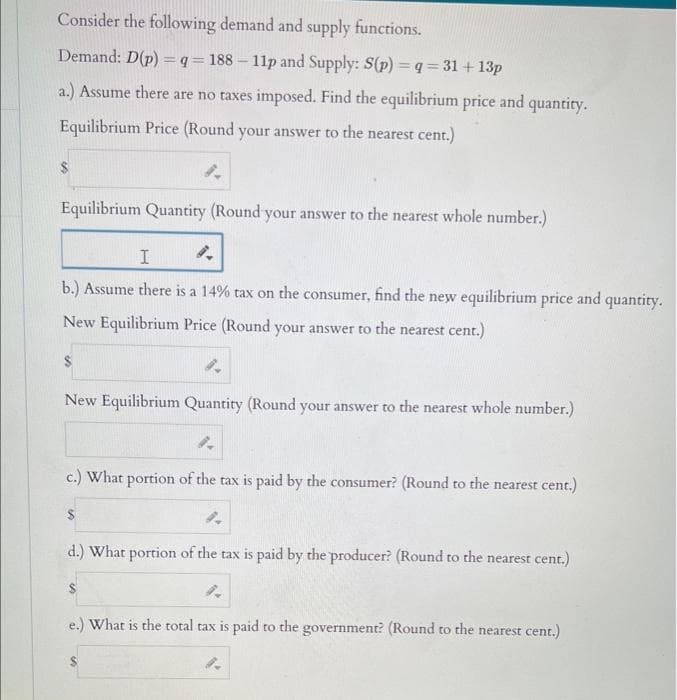Consider the following demand and supply functions. Demand: D(p) = q = 188-11p and Supply: S(p) = q = 31+ 13p a.) Assume there are no taxes imposed. Find the equilibrium price and quantity. Equilibrium Price (Round your answer to the nearest cent.) 4. Equilibrium Quantity (Round your answer to the nearest whole number.) I 9. b.) Assume there is a 14% tax on the consumer, find the new equilibrium price and quantity. New Equilibrium Price (Round your answer to the nearest cent.) 9. New Equilibrium Quantity (Round your answer to the nearest whole number.) 4.
Consider the following demand and supply functions. Demand: D(p) = q = 188-11p and Supply: S(p) = q = 31+ 13p a.) Assume there are no taxes imposed. Find the equilibrium price and quantity. Equilibrium Price (Round your answer to the nearest cent.) 4. Equilibrium Quantity (Round your answer to the nearest whole number.) I 9. b.) Assume there is a 14% tax on the consumer, find the new equilibrium price and quantity. New Equilibrium Price (Round your answer to the nearest cent.) 9. New Equilibrium Quantity (Round your answer to the nearest whole number.) 4.
Principles of Microeconomics (MindTap Course List)
8th Edition
ISBN:9781305971493
Author:N. Gregory Mankiw
Publisher:N. Gregory Mankiw
Chapter8: Application: The Cost Of Taxation
Section: Chapter Questions
Problem 10PA
Related questions
Question

Transcribed Image Text:Consider the following demand and supply functions.
Demand: D(p) = q = 188-11p and Supply: S(p) = q=31+ 13p
a.) Assume there are no taxes imposed. Find the equilibrium price and quantity.
Equilibrium Price (Round your answer to the nearest cent.)
8.
Equilibrium Quantity (Round your answer to the nearest whole number.)
I
9.
b.) Assume there is a 14% tax on the consumer, find the new equilibrium price and quantity.
New Equilibrium Price (Round your answer to the nearest cent.)
New Equilibrium Quantity (Round your answer to the nearest whole number.)
4.
c.) What portion of the tax is paid by the consumer? (Round to the nearest cent.)
$
9.
d.) What portion of the tax is paid by the producer? (Round to the nearest cent.)
e.) What is the total tax is paid to the government? (Round to the nearest cent.)
9.
Expert Solution
This question has been solved!
Explore an expertly crafted, step-by-step solution for a thorough understanding of key concepts.
This is a popular solution!
Trending now
This is a popular solution!
Step by step
Solved in 2 steps with 2 images

Knowledge Booster
Learn more about
Need a deep-dive on the concept behind this application? Look no further. Learn more about this topic, economics and related others by exploring similar questions and additional content below.Recommended textbooks for you

Principles of Microeconomics (MindTap Course List)
Economics
ISBN:
9781305971493
Author:
N. Gregory Mankiw
Publisher:
Cengage Learning

Principles of Macroeconomics (MindTap Course List)
Economics
ISBN:
9781285165912
Author:
N. Gregory Mankiw
Publisher:
Cengage Learning

Essentials of Economics (MindTap Course List)
Economics
ISBN:
9781337091992
Author:
N. Gregory Mankiw
Publisher:
Cengage Learning

Principles of Microeconomics (MindTap Course List)
Economics
ISBN:
9781305971493
Author:
N. Gregory Mankiw
Publisher:
Cengage Learning

Principles of Macroeconomics (MindTap Course List)
Economics
ISBN:
9781285165912
Author:
N. Gregory Mankiw
Publisher:
Cengage Learning

Essentials of Economics (MindTap Course List)
Economics
ISBN:
9781337091992
Author:
N. Gregory Mankiw
Publisher:
Cengage Learning

Principles of Macroeconomics (MindTap Course List)
Economics
ISBN:
9781305971509
Author:
N. Gregory Mankiw
Publisher:
Cengage Learning

